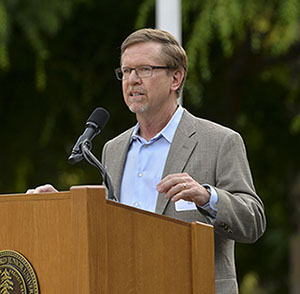
Photo of Gordon Saul, courtesy of
Stanford Byers Center for Biodesign
Supporting innovation around the greatest healthcare needs
Imagine if every time you saw a blackfly, you worried that its bite might infect you with a parasitic worm that could cause intense itching, skin nodules, eye lesions, and eventually blindness. In rural central Africa, this is a daily reality. A tropical disease called onchocerciasis or “river blindness,” impacts 20 million people and threatens 125 million more.
In its early stages, river blindness is often difficult and painful to detect. Current methods include blood or “skin snip” tests, where clinicians remove small sections of a patient’s skin and examine them under a microscope to determine the presence of parasites. At Stanford, the Byers Center for Biodesign challenged undergraduate bioengineering students to solve problems related to this devastating condition by applying its need-driven multidisciplinary innovation methodology. Students came up with a cost-efficient and compassionate means of diagnosis that uses a blue light to view the tissue under a microscope, eliminating the need for skin snips.
Every year, trainees at different levels of study, from undergraduates through faculty fellows, set their sights on tackling compelling unmet clinical needs—from river blindness to COVID-19 to geriatric quality-of-life issues—in hopes of positively impacting healthcare with pragmatic innovations to help countless patients around the world.
“It's really about building future leaders who, as part of their career goals, make a positive impact on the world through innovation by inventing and bringing to market technologies that will make a real difference for patients,” said Lyn Denend, director of Academic Programs at Stanford Byers Center for Biodesign.
“We couldn't support the development of those future innovators through a program such as this without gifts like the donation from BD,” said Gordon Saul, executive director at Stanford Byers Center for Biodesign, which received a $450,000 grant from BD.
A best-in-class approach to solving real healthcare challenges
One of BD’s core funding priorities is expanding access to healthcare. That’s why the Stanford program’s needs-driven philosophy of healthcare innovation made it a great candidate for a BD grant. Through support of the program, BD is helping brilliant minds address tough healthcare challenges that pose significant threats to vulnerable populations.
“What really was exciting about funding the Biodesign program at Stanford is that it perpetuates best-in-class methods of identifying the most problematic real-world challenges related to healthcare,” said Allan Spina, Vice President, R&D – Portfolio Management & Innovation Training at BD. “The Stanford Biodesign program tackles healthcare problems that should be solved—not just the problems that could be solved—leveraging innovation to tackle the right challenges at the right time for the right reasons.”
How Stanford is uniquely preparing students to uncover and solve problems
Rather than focusing on one-off, incubator-style projects, the Stanford program teaches students and fellows how to implement a repeatable process to fuel innovation. That process is useful not just in university settings, but in business and non-profit settings too.
“These trainees are all super bright and motivated to make an impact, but they struggle with how exactly to do that. It’s intimidating to think of making mistakes. It’s easy to stall and circle and never really get going,” said Saul. “We give participants a framework, and if they follow it effectively, they have a much better chance of being able to have their inventions go out and make a difference in the world.”
Program participants work in multidisciplinary teams. “We bring clinical, technical and business expertise into these teams very early on, so that they start to understand how things happen in the real world,” said Denend. While fellows uncover needs by spending weeks directly observing the delivery of care in hospitals and clinics, students in Biodesign’s courses use a real-world healthcare scenario as a jumping off point to begin their own research into how an important unmet need can be addressed through innovation. Along the way, they have access to expert guidance. “We mobilize a lot of folks from the health technology community around us, so participants get a pretty personalized, heavily mentored experience as they go through the program,” said Denend. “Students are really fired up about this kind of learning.”
This year, the pandemic has necessitated creative solutions for engaging students and promoting team-based learning in a virtual environment. “COVID has changed almost everything to some degree for all of our student-facing programs,” said Denend. Participants can’t meet in person, nor can they access the labs or facilities on campus, but they must still meet tight timelines and even prototype their innovations. “We're sort of working around the clock to experiment with different approaches in a pilot learn, repeat, improve cycle.” Denend noted that she wouldn’t be surprised to find some great unmet needs related to this crisis as well.
A bright future for med tech innovation
Graduates of the program have gone on to found more than 50 companies based on projects initiated during their training, though many decide to remain in their respective disciplines, such as engineering or clinical fields. “But they're now empowered to be innovators, alongside of their clinical or technical responsibilities, and that's really powerful,” said Saul.
Over the years, the ripple effects of the Stanford methodology have traveled well beyond the graduates themselves. The Stanford approach has found its way into companies that continuously push the boundaries of innovation every day to achieve substantial real-world impact. As one of the largest med tech companies in the world, at BD we’re integrating these practices in unique ways within our organization to help us continue to drive best-in-class innovation and breakthrough healthcare discoveries.
To learn more about the Stanford Byers Center for Biodesign, visit biodesign.stanford.edu.
Subscribe to receive BD blog alerts